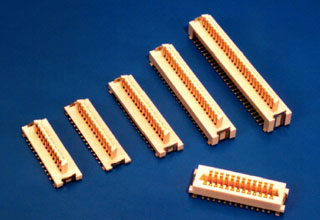When the price of gold shot up in the ’80s, many connector manufacturers funded research into gold alternatives. In the early days, much of that work was focused on Palladium. As it turned out, Palladium is a rather brittle material that has a tendency to crack when formed after plating. But in the process, palladium nickel plating emerged as a plating formula that was ductile enough to work well in electronic connectors.

Customers were quite skeptical, as you can imagine. Who wants to be the first to bet the company’s reputation just to save some money in gold costs. Not to mention the personal job risk of such a direction. So industry leaders, especially DuPont, went to work conducting the testing necessary to convince their customers that Palladium Nickel (PdNi) with a thin gold layer on top was as good as gold. In fact, they found that several characteristics of the PdNi plating enabled a plating that was more durable than gold. This was accomplished by using nickel under the plate, just like before, but adding a layer of PdNi on top and then a gold flash layer on the surface. The PdNi layer is harder and more durable than gold. The soft gold flash on the surface acts like a solid lubricant, moving around with each mating cycle, effectively filling in valleys in the PdNi plating and creating a smooth surface that proved to be quite durable when mated many cycles. So the PdNi plating with gold flash proved to be a superior plating to traditional 30-micro inch gold plating.
High cycle life is a very valuable characteristic for many connectors, especially in IO connectors that are mated and unmated every day, in test systems and even modular jacks. Molex, for example, reports that modular jacks plated with PdNi and gold flash are rated for 2500 mating cycles while the comparable gold plated jacks are only rated for 750 cycles.
PdNi plating with gold flash also proved to be superior to gold in porosity testing, environmental corrosion resistance, and creep corrosion. If using gold in a corrosive environment, the corrosion product actually grows or creeps across the surface of the gold, eventually contaminating the mating point and potentially causing failures. The chemistry of PdNi plating is such that the corrosion products do not creep. This allows some connector contacts with bare edges or points where the contact was removed from the carrier strip to pass environmental exposure while the comparable gold plated connector will fail.
PdNi plating with gold flash has become the preferred alternative for FCI, Molex, and TE Electronics, with products sold in very high volume for the last 25 years and performing well in the field.
Another alternative that is finding some success is nanocrystaline nickel, also used with a gold flash. This plating was invented at MIT and is licensed to the connector industry by Xtalic, a specialty plating chemistry firm in Connecticut. Contacts plated with this low-gold formula have also passed the rigorous requirements of Telcordia 1217 core environmental testing and IEC60603-7 PL 2.
By the way, precious metals used in connectors are all subject to the vagaries of the commodity market. Between 1999-2001, after the industry spent millions to prove that PdNi was acceptable and lower cost, the price of Palladium went through the roof, exceeding gold in similar applications. This spike in Palladium prices was largely driven by the use of Palladium as a catalyst in automotive catalytic converters. Fortunately, supply caught up with demand and now PdNi plating remains less expensive than gold plating. It might not always be that way, so caveat emptor.
Many connector companies offer parts with nickel plating with “gold flash” on top without specifying a thickness. This plating is normally less than 5 u-in. of gold and is largely cosmetic, not offering the protection of thicker gold plating. This kind of plating is most likely found in connectors used in low cost personal computers and similar commodity devices where long life is not important and cost is. You get what you pay for!
My message to you is that at least two plating alternatives have been through the qualification gauntlet at major connector suppliers and major OEMs and have proven to be reliable alternatives at a lower cost than 30 micro inch gold plating. PdNi with gold flash has proved to be superior. Performance testing based on Telcordia 1217 Core specifications has enabled connector manufacturers to prove that these alternatives to gold can perform well in even high end telecom and computing applications.
When selecting part numbers, be sure to consider the cost advantage of these gold alternatives. Your finance department will love you and the risk today is quite low. You might even get an award for a cost-saving suggestion that will help with the holiday shopping.

Another alternative to gold and PdNi plating is PVD (physical vapor deposition) coated contact coatings. PVD allows coating of alloys that cannot be plated, e.g. very tarnish resistant silver alloys. One such alloy, Silver MaxPhase form the company Impact Coatings (www.impactcoatings.se) is qualified to replace gold plating in e.g. mobile phone applications. The PVD alternatives are both cost efficient and eco-friendly. Eco-friendly as the coating method is dry and clean without the health and environment threatening cyanide used on plating of noble metals.
Is There any reference aplications for silver maxphase avalible on the market today?
Silver MaxPhase is qualified by multiple connector manufacturers. Products not yet on the market.